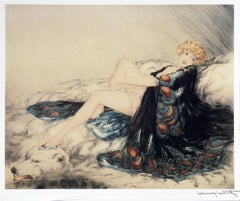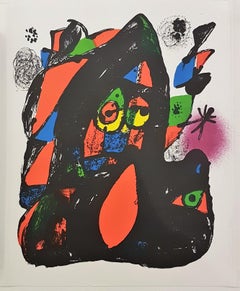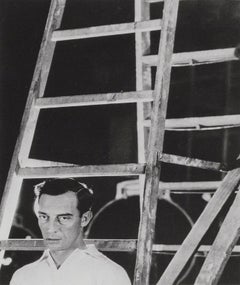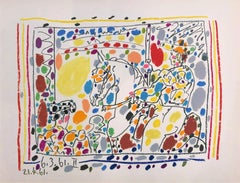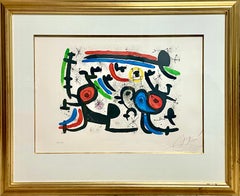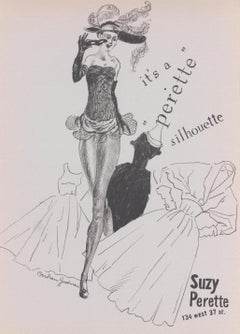Art by Medium: Lithograph
to
9,131
16,096
6,070
9,053
3,435
1,681
Overall Width
to
Overall Height
to
66
5,710
28,272
2,313
363
400
1,023
1,147
1,514
3,673
4,776
6,610
3,307
1,218
45
10,488
3,961
3,339
2,327
1,557
971
799
589
472
132
99
87
57
46
24,428
11,242
578
16,078
8,647
5,745
5,472
4,836
3,799
3,543
2,435
2,233
2,225
1,982
1,374
1,366
1,299
1,147
1,006
922
875
843
736
36,361
184,209
97,222
78,241
77,197
810
753
358
343
292
3,723
11,752
19,629
12,959
Medium: Lithograph
Silk Robe, Art Nouveau Offset Lithograph by Louis Icart
By Louis Icart
Located in Long Island City, NY
Louis Icart, French (1888 - 1950) - Silk Robe, Medium: Offset Lithograph on paper, signed in plate, Image Size: 17.5 x 21.5 inches, Size: 19 x 22.5 in. (48.26 x 57.15 cm), Descrip...
Category
Early 20th Century Art Nouveau Art by Medium: Lithograph
Materials
Lithograph, Offset
Lithographie Originale (Cover)
By Joan Miró
Located in Kansas City, MO
Joan Miró
Lithographie Originale (Cover)
Color Lithograph
Year: 1981
Size: 15.6 × 12.75 inches
Catalogue Raisonné: Cramer 177, Der Lithograph IV, 1969-1972, Ref.: 1255, p.178
Publisher: Maeght Editeur, Paris, France
With coverfold, recto - as issued
Recto, right: Typographically annotated: 'Lithographie Originale'
Unsigned, Unknown Edition Size
COA provided
---------------------------------------
Joan Miró i Ferrà was a Spanish painter, sculptor, and ceramicist born in Barcelona. A museum dedicated to his work, the Fundació Joan Miró, was established in his native city of Barcelona in 1975, and another, the Fundació Pilar i Joan Miró, was established in his adoptive city of Palma de Mallorca in 1981
Surrealism, Fauvism, Cubism, Abstract expressionism, Naive art, Expressionism, Suprematism
Pablo Picasso, André Breton, Hans Arp, André Masson, Hieronymus Bosch, Tristan Tzara, Modest Urgell
Category
1980s Abstract Expressionist Art by Medium: Lithograph
Materials
Lithograph
$149 Sale Price
69% Off
Cecil Beaton, Buster Keaton, from Electa Editrice Portfolios, 1981 (after)
By Cecil Beaton
Located in Southampton, NY
This exquisite heliogravure after Sir Cecil Beaton (1904–1980), titled Buster Keaton, from the folio Cecil Beaton, Electa Editrice Portfolios, 1981, originates from the 1981 edition ...
Category
1980s Modern Art by Medium: Lithograph
Materials
Lithograph
$716 Sale Price
20% Off
Le Picador II
Located in New York, NY
This lithograph in 24 colors on Wove paper was created in 1961. Dated twice by the artist within the original lithograph plate, unsigned as issued. Published by Andre Sauret, Monte C...
Category
20th Century Modern Art by Medium: Lithograph
Materials
Lithograph
"Les amoureux et luna park II"
By Joan Miró
Located in Warren, NJ
Frame: 47.5 x 39.5 x 2
Picture: 32.5 x 22.5
Frame has a lot of ware
Picture itself is in excellent condition
Category
1980s Art by Medium: Lithograph
Materials
Lithograph
original lithograph
Located in Henderson, NV
Medium: original lithograph. This lithograph is from the rare 1954 "Improvisations" portfolio, published by the Artists Equity Association of New York on the occasion of the 1954 Spr...
Category
1950s Art by Medium: Lithograph
Materials
Lithograph
ALL THE PEOPLE Signed Lithograph, For My People-Margaret Walker, Rainbow Faces
Located in Union City, NJ
ALL THE PEOPLE is an original hand drawn limited edition lithograph by the highly acclaimed African-American woman artist Elizabeth Catlett, master printmaker and sculptor best known...
Category
1990s Contemporary Art by Medium: Lithograph
Materials
Lithograph
Original 'Aarau Ladet Ein' vintage Swiss travel poster
Located in Spokane, WA
Original poster. Linen-backed original Swiss poster "AARAU LADET EIN" An old travel poster with a modern flair to visit Aarau. It has a bea...
Category
1950s Abstract Art by Medium: Lithograph
Materials
Lithograph
$1,039 Sale Price
20% Off
1895 original poster by Maurice Réalier-Dumas for Champagne Jules Mumm & Co
Located in PARIS, FR
This 1895 original poster by Maurice Réalier-Dumas was created to promote Champagne Jules Mumm & Co and was featured in the prestigious "Les Maîtres de l’Affiche" (Plate 111) series....
Category
1890s Art by Medium: Lithograph
Materials
Lithograph, Paper
Picasso and the Human Comedy, Verve Lithograph Print, 1954 Oringinal Lithograph
Located in London, GB
Picasso and the Human Comedy, Verve, Vol. VIII, No 29/30, 1954
Original lithographs published by Mourlot Frères
Original lithograph print from Verve Vol. VIII, No 29/30 printed by t...
Category
Mid-20th Century Modern Art by Medium: Lithograph
Materials
Lithograph
"Apparition at the Border of Language"
Located in Lyons, CO
This print presents a fictitious encounter between contemporary colonial forces and Native Americans who are defenders of immigrant refugees and displaced populations.
The artist de...
Category
2010s Contemporary Art by Medium: Lithograph
Materials
Lithograph
Joan Miro, The Three Blues, from Derriere le miroir, 1951
By Joan Miró
Located in Southampton, NY
This exquisite lithograph by Joan Miro (1893–1983), titled Les Trois Bleus (The Three Blues), from the folio Derriere le miroir, Sur Quatre Murs (Behind the Mirror, On Four Walls), N...
Category
1950s Surrealist Art by Medium: Lithograph
Materials
Lithograph
$1,996 Sale Price
20% Off
Fashion Designer
Located in Hollywood, FL
ARTIST: Salvador Dali
TITLE: Fashion Designer
MEDIUM: Lithograph
SIGNED: Hand Signed
PUBLISHER: Levine & Levine for DALART
EDITION NUMBER: I 234/250
MEASUREMENTS: 21" x 29"
...
Category
1980s Surrealist Art by Medium: Lithograph
Materials
Lithograph
1956 lithography by Jean-Gabriel Domergue - Sylvie la manucure
Located in PARIS, FR
The 1956 lithography by Jean-Gabriel Domergue Sylvie la manucure, part of the renowned La Parisienne portfolio, stands as an elegant representation of post-war French art and a celeb...
Category
1950s Art by Medium: Lithograph
Materials
Lithograph, Paper
Henri Matisse, Series B, Var. 1, Dessins, Themes et Variations, 1943 (after)
Located in Southampton, NY
This exquisite lithograph after Henri Matisse (1869–1954), titled Series B, Variation 1, originates from the rare 1943 folio Henri Matisse, Dessins, Themes et Variations. Published b...
Category
1940s Fauvist Art by Medium: Lithograph
Materials
Lithograph
$796 Sale Price
20% Off
Rise I (The swan on a blue-green background)
Located in Paris, FR
Lithograph, 1961
Edition : 41/100
Publisher : Maeght, Paris
Printer : Maeght, Paris
Catalog : [Vallier n°161 p.230; Mourlot n°100]
48.50 cm. x 65.50 cm. 19.09 in. x 25.79 in. (pap...
Category
1960s Abstract Art by Medium: Lithograph
Materials
Lithograph
1983 After Sondra Freckelton 'Celebration' Contemporary Lithograph
By Sondra Freckelton
Located in Brooklyn, NY
Paper Size: 34.25 x 25 inches ( 86.995 x 63.5 cm )
Image Size: 28 x 23.5 inches ( 71.12 x 59.69 cm )
Framed: No
Condition: A-: Near Mint, very light signs of handling
Shippin...
Category
1980s Art by Medium: Lithograph
Materials
Lithograph
$120 Sale Price
20% Off
You buy a Liberty Bond Lest I Perish original World War 1 vintage poser
Located in Spokane, WA
Original vintage poster: YOU Buy a Liberty Bond. Linen Backed World War 1 bonds poster. Archival linen backed in good condition; ready to frame. Artist: C . R. Macauley created...
Category
1910s American Realist Art by Medium: Lithograph
Materials
Lithograph
Paris : Saint Germain des Pres - Original Lithograph Handsigned and Numbered
Located in Paris, IDF
Urbain HUCHET
Paris : Saint Germain des Pres, c. 1980
Original lithograph
Handsigned in pencil by the artist
Numbered / 350 copies
On Arches velllum 15 x 18 cm (c. 6 x 7 in)
Excell...
Category
Late 20th Century Post-Impressionist Art by Medium: Lithograph
Materials
Lithograph
THE LANTERN Hand Signed Lithograph, Collage Portrait, African American Heritage
Located in Union City, NJ
THE LANTERN is an original, handmade limited edition lithograph printed in 13 colors from hand drawn lithography plates using traditional hand lithography methods on archival Somerse...
Category
1970s Contemporary Art by Medium: Lithograph
Materials
Lithograph
Bullfighting Poster with Manolete - Valencia, 31 July 1941
Located in London, GB
Carlos Ruano Llopis (1878-1950)
Original Vintage Bullfighting Poster
March 1953
107cm x 53cm
Carlos Ruano Llopis was born in 1878 in Orba, Spain ...
Category
1940s Other Art Style Art by Medium: Lithograph
Materials
Lithograph
Spanish Artist signed limited edition original art print numbered lithograph
By Joan Miró
Located in Miami, FL
Joan Miro (Spain, 1893-1983)
'Joan Miró. Fotoscop', 1974
lithograph on paper
12.9 x 20.5 in. (32.7 x 52 cm.). The size of the stamp paper has been slightly modified. Its original dim...
Category
1970s Abstract Art by Medium: Lithograph
Materials
Paper, Lithograph
Lions Club, Modern Art Lithograph by Jean Cocteau
By Jean Cocteau
Located in Long Island City, NY
A colorful signed lithograph by French Modern artist Jean Cocteau. This print features a stylized dancing lion with the title “Lions Club” in the upper left corner and a signature an...
Category
1950s Modern Art by Medium: Lithograph
Materials
Lithograph
$1,200 Sale Price
20% Off
Robert Burkert Lithograph Landscape "Late Light" Poetic
By Robert Burkert
Located in Detroit, MI
"Late Light" by Robert Burkert is a lithograph landscape by the master printmaker that depicts a clearing with autumn/winter trees in the subtle but vib...
Category
Late 20th Century Contemporary Art by Medium: Lithograph
Materials
Lithograph
Song of Songs - Lithograph by Marc Chagall - 1960s
By Marc Chagall
Located in Roma, IT
Song of Songs is an artwork realized by Marc Chagall, 1960s.
Lithograph on brown-toned paper, no signature.
Lithograph on both sheets.
Edition of 6500 unsigned lithographs. Printe...
Category
1960s Surrealist Art by Medium: Lithograph
Materials
Lithograph
$226 Sale Price
40% Off
Picasso, Lithograph Print, 1930 Editions des Chroniques du Jour.
Located in London, GB
Picasso, lithographs from 1930
From XXº Siecle, published in Paris, 1930
Published by Editions des Chroniques du Jour, as part of a limited edition, mounted in cream with a natural ...
Category
20th Century Art by Medium: Lithograph
Materials
Lithograph
TAKASHI MURAKAMI DOB & Me On the Red... Hand signed & numbered Superflat Pop Art
Located in Madrid, Madrid
TAKASHI MURAKAMI - Time Bokan Black
Date of creation: 2011
Medium: Offset lithograph with silver on paper
Edition: 300
Size: 50 x 50 cm
Condition: In mint conditions and not framed
O...
Category
2010s Pop Art Art by Medium: Lithograph
Materials
Varnish, Lithograph, Offset
Jean-Michel Basquiat Downtown 81 / New York Beat 1980
Located in NEW YORK, NY
Jean-Michel Basquiat Downtown 81 / New York Beat 1980:
Basquiat created this impossibly rare printed flyer to advertise a band performance within his feature acted film: Downtown 81 ...
Category
1980s Pop Art Art by Medium: Lithograph
Materials
Lithograph, Offset
Akira Kito, Child, from Prints from the Mourlot Press, 1964
Located in Southampton, NY
This exquisite lithograph by Akira Kito (1909–1995), titled Enfant (Child), from the album Prints from the Mourlot Press, exhibition sponsored by the French Embassy, circulated by th...
Category
1960s Modern Art by Medium: Lithograph
Materials
Lithograph
$716 Sale Price
20% Off
UNTITLED ABSTRACT(Dream Figures, Red Window) Lithograph, Organic Geometric Forms
By Knox Martin
Located in Union City, NJ
UNTITLED ABSTRACT(Dream Figures, Red Window) is an original hand drawn lithograph by the American abstract painter Knox Martin printed using hand lithography techniques on archival R...
Category
1980s Contemporary Art by Medium: Lithograph
Materials
Lithograph
L'atelier de Cannes
Located in OPOLE, PL
Pablo Picasso (1881-1973) - L'atelier de Cannes
Lithograph from 1958.
On Arches paper.
Dimensions of work: 44.8 x 33.4 cm.
Plate signed.
It's an enhanced version of the first st...
Category
1950s Modern Art by Medium: Lithograph
Materials
Lithograph
$4,909 Sale Price
20% Off
Robert Motherwell 'Sculpture '76' 1976
Located in Brooklyn, NY
Lithograph poster for a Robert Motherwell exhibit at The Greenwich Arts Council in 1976. Published by Tyler Graphics LTD. Printed on heavy stock.
Paper Size: 37.25 x 23 inches ( 9...
Category
1970s Art by Medium: Lithograph
Materials
Lithograph
American Crow 1858 Chromolithograph by J.J. Audubon Plate, Julius Bien Edition
Located in Paonia, CO
American Crow by J.J. Audubon from his Birds of America folio shows an adult male crow in a Black Walnut bush with a nest of a Ruby-Throated Hummingbird in a branch below the crow. This original chromolithograph plate no. 226 is in good condition with a repairable water mark in the image on the left side as can be seen in the photos.
The ” Birds of America” by John James...
Category
1850s Naturalistic Art by Medium: Lithograph
Materials
Lithograph
1956 lithography by Jean-Gabriel Domergue - L'enlèvement de Sabine
Located in PARIS, FR
The 1956 lithography by Jean-Gabriel Domergue L'enlèvement de Sabine, part of the renowned La Parisienne portfolio, stands as an elegant representation of post-war French art and a c...
Category
1950s Art by Medium: Lithograph
Materials
Lithograph, Paper
Composition abstraite
By Chu Teh-Chun
Located in OPOLE, PL
Chu Teh-Chun (1920-2014) - Composition abstraite
Lithograph from 1960.
Edition 60/60.
Dimensions of work: 63.5 x 48.5 cm.
Hand signed.
Publisher: Galerie de France, Paris.
Dime...
Category
1960s Modern Art by Medium: Lithograph
Materials
Lithograph
Alexander Calder, Mama Citron, from Derriere le Miroir, 1975
Located in Southampton, NY
This exquisite lithograph by Alexander Calder (1898–1976), titled Mama Citron, originates from the historic 1975 folio Derriere le Miroir, No. 212. Published by Maeght Editeur, Paris...
Category
1970s Surrealist Art by Medium: Lithograph
Materials
Lithograph
$716 Sale Price
20% Off
HARBINGER OF SPRING Signed Lithograph, Farm House Landscape Blue Sky White Barn
By Mel Hunter
Located in Union City, NJ
HARBINGER OF SPRING is an original limited edition, hand drawn lithograph(not a photo reproduction or digital print) by the American artist/illustrator Mel Hunter, printed using hand...
Category
1970s Realist Art by Medium: Lithograph
Materials
Lithograph
Portrait au Cou Bleu, Cubist Lithograph after Pablo Picasso
Located in Long Island City, NY
Facing the viewer, the woman in this print is rendered in a linear style that emphasizes the geometric qualities of her form. A typical example of Pablo Picasso's Cubist portraits, his portrayal of the woman is angular and non-representative of reality, defying the tenets of traditional portraiture. A lithograph from the Marina Picasso Estate Collection after the Pablo Picasso painting "Portrait au Cou Bleu...
Category
Late 20th Century Cubist Art by Medium: Lithograph
Materials
Lithograph
Presso Ponza - Lithograph by Aldo Riso - 2003
By Aldo Riso
Located in Roma, IT
Lithograph on Magnani-Pescia paper. Paper size 17,5 cm x 24,5 cm work size 14,5 cm x22 cm . Excellent condition, no defects.
Aldo Riso was born in 1927 in Santa Maria di Leuca, in th...
Category
Early 2000s Contemporary Art by Medium: Lithograph
Materials
Lithograph
(after) Julio Gonzalez - "Personnage barbu" pochoir
Located in Henderson, NV
Medium: pochoir (after the watercolor). Printed in Paris in 1957 by Jacomet and published by the Galerie Berggruen for a rare catalogue. Image size: 6 3/4 x 3 3/4 inches (173 x 97 mm...
Category
1950s Surrealist Art by Medium: Lithograph
Materials
Lithograph, Stencil
Frank Stella, Line Up, from Jasper's Dilemma, signed/n, geometric abstraction
By Frank Stella
Located in New York, NY
Frank Stella
Line Up, from Jasper's Dilemma (Axsom 85), 1973
Lithograph in colors on J. Green mould-made paper
Signed, dated and numbered 56/100 in pencil lower right front
16 × 22 i...
Category
1970s Abstract Geometric Art by Medium: Lithograph
Materials
Lithograph
$11,600 Sale Price
20% Off
Dreaming Nude - Lithograph
Located in Paris, IDF
Moise KISLING
Dreaming Nude
Lithograph enhanced with watercolor stencil
Printed signature in the plate
On vellum 38 x 28 cm (c. 15 x 11 inch)
Very good condition
Category
1950s Modern Art by Medium: Lithograph
Materials
Lithograph, Stencil
Tete, Cubist Lithograph after Pablo Picasso
Located in Long Island City, NY
Shown in profile, the model in this Pablo Picasso print is split so that her profile is visible from the left and the right. A signature of his work, the absence of traditional persp...
Category
Late 20th Century Cubist Art by Medium: Lithograph
Materials
Lithograph
Wassily Kandinsky, Black and Violet, from Derriere le miroir, 1960 (after)
Located in Southampton, NY
This exquisite lithograph after Wassily Kandinsky (1866–1944), titled Schwarz und Violett (Black and Violet), from the folio Derriere le miroir, No. 118, originates from the 1960 edi...
Category
1960s Modern Art by Medium: Lithograph
Materials
Lithograph
$956 Sale Price
20% Off
Max Ernst, The Wheel of Light, from Natural History, 1972 (after)
By Max Ernst
Located in Southampton, NY
This exquisite collotype after Max Ernst (1891–1976), titled La Roue de la lumiere (The Wheel of Light), from the album Max Ernst, Histoire Naturelle (Natural History), originates fr...
Category
1970s Surrealist Art by Medium: Lithograph
Materials
Lithograph
$716 Sale Price
20% Off
Canaletto
Located in London, GB
A hand painted three dimensional, Reverspective print, inspired by Venice. Produced in 2024. This print comes housed in a bespoke perspex display case. A limited edition of 75.
Hand...
Category
2010s Contemporary Art by Medium: Lithograph
Materials
Lithograph, Offset
Tete de Femme, Cubist Lithograph after Pablo Picasso
Located in Long Island City, NY
A lithograph from the Marina Picasso Estate Collection after the Pablo Picasso painting "Tete de Femme". The original painting was completed in 1958. In the 1970's after Picasso's d...
Category
1980s Cubist Art by Medium: Lithograph
Materials
Lithograph
Le débarquement
By Jean Carzou
Located in OPOLE, PL
Jean Carzou (1907-2000) - Le débarquement
Lithograph from 1966.
Dedicated to Pierre Sorlier, on Arches paper.
Dimensions of work: 77.7 x 62.2 cm.
Hand signed.
The work is in Exc...
Category
1960s Modern Art by Medium: Lithograph
Materials
Lithograph
Profile III from "Le Gout du Bonheur", Cubist Lithograph after Pablo Picasso
Located in Long Island City, NY
Pablo Picasso, After, Spanish (1881 - 1973) - Profile III from "Le Gout du Bonheur". Year: 1964 (Printed 1970), Medium: Lithograph on Arches, Edition: 666, Size: 13 x 9.75 in. (33.02...
Category
1970s Cubist Art by Medium: Lithograph
Materials
Lithograph
My Mother Bridlington, Hand Signed Tate Gallery print, Ed. of 250 w/official COA
Located in New York, NY
David Hockney
My Mother (Bridlington), 1988
Four Color Lithograph on T.H. Saunders Waterford 250 gram paper. Hand signed. Also accompanied by a separate signed Certificate of Authent...
Category
1980s Pop Art Art by Medium: Lithograph
Materials
Lithograph, Offset
Spring Day from Derrier Le Miroir, Impressionist Lithograph by Marc Chagall
By Marc Chagall
Located in Long Island City, NY
Marc Chagall, Russian (1887 - 1985) - Spring Day from Derrier Le Miroir, Year: 1972, Medium: Lithograph, Size: 15 x 11 in. (38.1 x 27.94 cm), Printer: Mourlot, Paris, Publisher: Ma...
Category
1970s Impressionist Art by Medium: Lithograph
Materials
Lithograph
Braque, Quatre oiseaux, Derrière le miroir (after)
Located in Southampton, NY
Lithograph on vélin paper. Inscription: Unsigned and unnumbered, as issued. Good condition. Notes: From Derrière le miroir, N° 115, 1959. Published by Aimé Maeght, Éditeur, Paris; pr...
Category
1950s Modern Art by Medium: Lithograph
Materials
Lithograph
$716 Sale Price
40% Off
Takashi Murakami Flowers Skateboard Deck (Takashi Murakami skate deck)
Located in NEW YORK, NY
Takashi Murakami Flowers Skate Deck:
A vibrant piece of Takashi Murakami wall art produced as a limited series in conjunction with the 2017 Murakami exhibit: The Octopus Eats Its Own...
Category
1980s Pop Art Art by Medium: Lithograph
Materials
Wood, Lithograph, Offset
Andre Derain, In the Garden of Allah, from Verve, Revue Artistique, 1938
By André Derain
Located in Southampton, NY
This exquisite lithograph by Andre Derain (1880–1954), titled Au Jardin d'Allah (In the Garden of Allah), from Verve, Revue Artistique et Litteraire, Vol. I, No. 4, originates from t...
Category
1930s Fauvist Art by Medium: Lithograph
Materials
Lithograph
Tribute to Cezanne : The Bather - Original handsigned lithograph
Located in Paris, IDF
Jules CAVAILLES
Tribute to Cezanne : The Bather, 1966
Original lithograph
Handsigned in pencil
On Rives vellum 37 x 28 cm (c. 15 x 11 inch)
Excell...
Category
1960s Modern Art by Medium: Lithograph
Materials
Lithograph
$188 Sale Price
20% Off
Dali’s Inferno, Signed Surrealist Lithograph by Salvador Dali
Located in Long Island City, NY
Dali’s Inferno by Salvador Dali, Spanish (1904–1989)
Portfolio: Dali's Inferno
Date: 1978
Lithograph on Arches, signed and numbered in pencil
Edition of 2...
Category
1970s Surrealist Art by Medium: Lithograph
Materials
Lithograph
Picasso, Composition (Cramer 30; Horodisch D14; Bloch 307; Matarasso 28) (after)
Located in Southampton, NY
Lithograph on vélin paper. Unsigned and unnumbered, as issued. Good condition. Notes: From the volume, L'indicatif présent ou l'infirme del qu'il est, 1938. Published by Éditions Sou...
Category
1930s Cubist Art by Medium: Lithograph
Materials
Lithograph
$796 Sale Price
20% Off
original lithograph
Located in Henderson, NV
Medium: original lithograph. This lithograph is from the rare 1952 "Improvisations" portfolio, published by the Artists Equity Association of New York on the occasion of the 1952 Spr...
Category
1950s Art by Medium: Lithograph
Materials
Lithograph
'Plowing It Under' — WPA Era American Regionalism
Located in Myrtle Beach, SC
Thomas Hart Benton, 'Goin' Home', lithograph, 1937, edition 250, Fath 14. Signed in pencil. Signed in the stone, lower right. A fine, richly-inked impression, on off-white, wove pape...
Category
1930s American Realist Art by Medium: Lithograph
Materials
Lithograph
Picasso "Toros & Toreros" Photolithography
Located in Cuauhtemoc, Ciudad de México
This framed Picasso print, is an offset lithographic book plate from a captivating book, entitled Toros y Toreros (Bulls and Bullfighters), which ...
Category
Mid-20th Century Cubist Art by Medium: Lithograph
Materials
Lithograph
$560 Sale Price
20% Off
Lithograph art for sale on 1stDibs.
Find a wide variety of authentic Lithograph art available on 1stDibs. While artists have worked in this medium across a range of time periods, art made with this material during the 21st Century is especially popular. If you’re looking to add art created with this material to introduce a provocative pop of color and texture to an otherwise neutral space in your home, the works available on 1stDibs include elements of blue, orange, yellow, red and other colors. There are many well-known artists whose body of work includes ceramic sculptures. Popular artists on 1stDibs associated with pieces like this include Joan Miró, Marc Chagall, Peter Max, and Alexander Calder. Frequently made by artists working in the Modern, Contemporary, all of these pieces for sale are unique and many will draw the attention of guests in your home. Not every interior allows for large Lithograph art, so small editions measuring 0.01 inches across are also available
